Olivier Véran mentioned Thursday, February 18 in his weekly point devoted to the Covid-1 health crisis, the climate sensitivity of the coronavirus. “There are parameters that we follow very closely in France, in particular the weather parameter with the Predict indicator, which shows that the situation was better a few days ago because it was very cold due to the polar vortex Siberian. Currently, the situation has rather deteriorated from the point of view of weather indexes (softer, wetter, editor’s note). “
Temperature and humidity: an impact on the transmission of the virus
The company Predict Services, subsidiary of Météo France, mentioned by the Minister of Health specializes in risk management. It has set up a climate transmissivity index for the virus based on data from Météo France. According to her, temperature and humidity can play a role in the transmission of the virus.
Concretely, the droplets which carry the virus would be transmitted better when the temperature is close to 6 ° C and the humidity around 75%, in other words when the weather is rather mild and humid. Conversely, the droplets would fall to the ground (therefore would be less transmissible) in the event of low temperature close to 0 ° C and with humidity around 40 to 50% (a dry cold so). When it is hot (15-20 ° C) the droplets evaporate, also reducing the transmissibility of the virus.
From these data, the company created the “Covid Climate Transmission Predict Index“As a result, the correlation between weather data and Covid-19 cases seems to hold up.”During the first wave in France, the largest number of cases in the Grand-Est, Île de France, Rhône-Alpes and a little in the Hauts de France corresponded to areas where in January, February and March our index was the strongest. On the other hand, in the less affected regions, the southwest in France, the Mediterranean border or Brittany, our index was the lowest.“, explains Alix Roumagnac of Predict Services to our colleagues at France Bleu.
From May, with the rise in temperatures, Predict’s IPTCC index turned green. Then, following the cooling following the passage of the storm Alex at the end of September, the contaminations resumed by the Massif Central, in the Rhône-Alpes and in Île de France, the index going back to yellow, then orange.
Barrier gestures are also linked to the weather!
From there to forecast a “Covid” weather forecast? While these data are interesting, they are not enough on their own to predict the spread of SARS-CoV-2, because it is clear that other parameters affect the spread of the virus. Moreover, the links between climate and the spread of the coronavirus have been very studied for a year by scientists around the world and for the moment there is no consensus.
So far, many studies have shown that cases of people affected by other viruses, such as the flu or the common cold, coincided with a drop in outside temperature. According to a study by the Academy of Medicine dating from last May, when the temperature rises by 1 ° C, the number of new cases of coronavirus decreases by 3.1%. If this reduction makes it possible to go in the direction of an accreditation of the thesis of a better transmission of the virus in cold weather, nothing makes it possible to draw a theory from it.
As Professor Christine Katlama, an infectious disease specialist at the Pitié-Salpêtrière hospital, explains, it is difficult to completely confirm this hypothesis. It would indeed take a cycle of complete seasons in both hemispheres to confirm this. However, this respiratory virus is recent and new. For many other respiratory viruses, it has been established that, in fact, the cold seasons favor the transmission of infections. Which can be explained by the fact that people spend more time indoors, ventilate the rooms less where they are, among other reasons.
If we observe what is happening on a global scale, it is the same: no data confirms greater virulence in winter than in summer.
The only hypothesis of which we are more or less certain is that coming into close contact with other people outside your home gives the virus an opportunity to spread, whatever the temperature. People who do not live under the same roof and wish to be together, must therefore respect the barrier gestures to limit the risks: namely to maintain a physical distance of at least one meter between each person, to wear a mask in closed spaces, regularly ventilate the rooms where you walk, avoid hugs and physical contact and wash your hands thoroughly.
Sources:
- Olivier Véran press conference, February 18, 2021.
- Interview Christine Katlama, infectious disease specialist at Pitié-Salpêtrière hospital, December 2020.
- France bleu, December 20, 2020.
Read also:
- Covid-19 and Christmas: gauge of 6 adults at the table and barrier gestures
- Covid-19 is three times more deadly than the flu
- Vaccination campaign: stages, priorities
- Covid-19 antigen test: why a negative result should not (too) reassure you


















